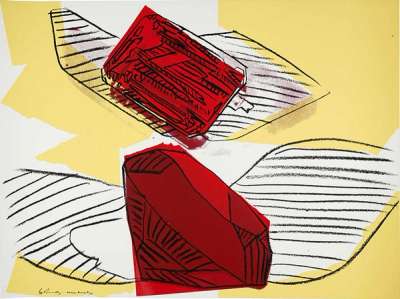
Gems (F. & S. II.89)

Gems (F. & S. II.89)
Signed Print
Andy Warhol
Price data unavailable
AAGR (5 years) This estimate blends recent public auction records with our own private sale data and network demand.
There aren't enough data points on this work for a comprehensive result. Please speak to a specialist by making an enquiry.
Medium: Screenprint
Edition size: 20
Year: 1978
Size: H 76cm x W 102cm
Signed: Yes
Format: Signed Print
Track this artwork in realtime
Watch artwork, manage valuations, track your portfolio and return against your collection
Meaning & Analysis
Printed in 1978, Gems (F. & S. II.89) is a signed screen print in colour on Strathmore Bristol paper by Andy Warhol. The print depicts a round cut emerald gem. The print is rendered in a magnificent variety of greys, greens and blues against a plain backdrop. The large gemstone occupies the centre of the composition, dominating the print and drawing the viewer’s attention towards the spectacular gem. Black hand-drawn gestural lines add dimensions and texture to the still life, bringing dynamism to the print.
Gems (F. & S. II.89) is part of the Gems series, produced in 1978 towards the end of Warhol’s artistic career. This series is composed of four screen prints each depicting a precious gemstone, such as rubies, diamonds and emeralds. This series marks a departure from Warhol’s widely recognised depictions of celebrity culture. The inanimate objects which become the focus of this series contrast with Warhol’s prints of stars and 20th century icons such as Marilyn Monroe and Elvis Presley. Nevertheless, the gems in this series are the embodiment of the beauty and glamour that fascinated Warhol and led to his obsession with celebrities.
The print is characterised by Warhol’s experimentation with lines and colour. Gems (F. & S. II.89) reflects Warhol’s more expressive turn, which came to dominate the prints he produced later on in his career such as the Skull and Mick Jagger series. This experimental approach differs greatly from the mechanical aesthetic of his earlier work, such as the Campbell’s Soup series, as well as his more traditional approach to still life drawing that underlined his work as a freelance commercial illustrator in the 1950s.
Andy Warhol was a leading figure of the Pop Art movement and is often considered the father of Pop Art. Born in 1928, Warhol allowed cultural references of the 20th century to drive his work. From the depiction of glamorous public figures, such as Marilyn Monroe, to the everyday Campbell’s Soup Can, the artist challenged what was considered art by blurring the boundaries between high art and mass consumerism. Warhol's preferred screen printing technique further reiterated his obsession with mass culture, enabling art to be seen as somewhat of a commodity through the reproduced images in multiple colour ways.


